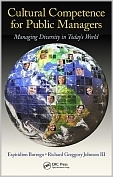| |||||
• polskie
• Zamów informacje o nowościach z wybranego tematu • kontakt |
CULTURAL COMPETENCE FOR PUBLIC MANAGERS: MANAGING DIVERSITYBORREGO E. / IN TODAY'S WORLDwydawnictwo: CRC PRESS, 2011, wydanie Icena netto: Providing public managers with the tools to manage diverse and multicultural employees, avoid cultural missteps, and create optimal performing organizations, this unique book is grounded in solid theoretical conceptual models, successful government and private sector practices, and international collaborations. Organized thematically, it defines the scope of cultural competence, highlights best practices, and describes variations in responsibility for administering cultural competence for executives, managers, supervisors, and employees. The authors give expert advice for building a culturally competent organization and troubleshooting cultural competence issues. Espiridion Borrego, University of Texas Pan American, Edinburg, USA Richard Gregory Johnson III, University of Vermont, Burlington, USA Table of Contents
INTRODUCTION TO CULTURAL COMPETENCE: DO I REALLY NEED TO BE CULTURALLY COMPETENT? Why Cultural Competence Is Important Introduction to and Short History of Cultural Competence Why Public Managers Need to Be Culturally Competent Obstacles to Cultural Competence Cultural Characteristics Perceptions of Time Other Dimensions of Culture Questions That Need to Be Asked about Cultural Competence Why a New Cultural Competence Model Is Needed What Public Managers Need to Know about Cultural Competence as a Leadership Competence Top 10 Reasons Why Cultural Competence Is Important Summary and Conclusion How Globalization and Immigration Are Changing the World Introduction The United Central and Latin America Africa Additional Commentary on Generational Issues Additional Commentary on International Cultural Issues Summary and Conclusion Defining Cultural Competence for Public Managers Introduction Research on Cultural Competence Definitions of Cultural Competence Cultural Intelligence and Its Contribution to Cultural Competence Cultural Intelligence and Leadership Understanding Diversity, Social Equity, and Cultural Competence Summary and Conclusion Cultural Competencies Introduction Developing the Foundation Cultural Competencies Foundation Cultural Competencies Respecting and Understanding Culture Communicating with Culturally Diverse Employees Creating Common Ground or a Shared Culture Being Adaptable and Flexible Inclusiveness as a Way to Create Effective Teams and Collaboration Summary and Conclusion CULTURAL COMPETENCE FOR EXECUTIVES, MANAGERS, SUPERVISORS, AND EMPLOYEES Experiences from Successful Multicultural and Diversity Programs Introduction Cross-Cultural Lessons The Multicultural Leadership Program Examples of Public Sector Initiatives Learning from the Private Sector and Public Sector Initiatives Summary and Conclusion Cultural Competencies for Executives Introduction Cultural Competencies for Executives The Political Appointee and Career Civil Servants Major Department Heads Leveraging Diversity Creating the Future by Leveraging Diversity as a Strategic Goal Preparing the Organization to Be Culturally Competent: Shaping the Organizational Culture Communicating to Inspire Diverse and Multicultural Employees Developing and Mentoring Managers to Be Culturally Competent Summary and Conclusion Cultural Competencies for Middle Managers and Supervisors Introduction Cultural Competencies for Managers and Supervisors Developing Culturally Competent Managers Mentoring Multicultural Managers Becoming a Culturally Competent Mentor Mentoring Career Skills Supervisors Summary and Conclusion Cultural Competencies for Employees Introduction Cultural Competencies for Employees Establishing Leadership Cultural Competencies for Employees Developing a Long-Term Career Plan Creating a Long-Term Career in Diverse and Multicultural Organizations Acquiring Diverse and Multicultural Mentors Creating Relationships with Diverse and Multicultural Employees Executive Protocols and Manners Summary and Conclusion BUILDING THE CULTURALLY COMPETENT ORGANIZATION
Establishing the Organizational Cultural Competence Framework Introduction The High-Performance Organization How Current and Future Situations Set the Stage for Culturally Competent Practices Reasons for Culturally Competent Policies The Culturally Competent Organization Defining Diversity Creating Culturally Competent Practices Creating a Supportive Organizational Climate Summary and Conclusion Human Resource Management and Cultural Competence Introduction The Evolving Field and Its Inattention to Diversity Managing Diversity Obstacles in Diversifying HRM Curricula: A Lack of Teacher Preparation and Coverage Why Is HRM Curricular Reform Needed? Elements of Diversity Creating Culturally Competent Orientation Programs Cultural Competence Organizational Measures Human Resources as the Feedback Loop for Policy Development Summary and Conclusion Using Cultural Competence to Develop International Collaborations Introduction: Cultural Competence in Context Race Theory What’s Up with Xenophobia? The Recent Passage of Arizona’s Controversial Bills International Collaborations for Public Managers Creating International Opportunities Developing International Relationships Universities and International Collaborations Working through Difficult Issues Maintaining International Relationships Summary and Conclusion CASES IN CULTURAL COMPETENCE Cultural Competence in Health Care Introduction The Federal Government’s Role in Developing Cultural Competence in Health Care Delivery of Services Culturally Competent Health Administration Culturally Competent Hospital Administration Culturally Competent Human Services Administration Additional Resources on Cultural Competency in Health Care Medical Tourism Summary and Conclusion Cultural Competence in Higher Education Introduction Reasons for Higher Education Cultural Competency Models The Tilford Group Cultural Competence Model Challenges in Building a Cultural Competency Curriculum Overcoming Obstacles to Culturally Competent Faculty Cultural Competence for University Administrators Summary and Conclusion Resolving Difficult Employee Issues Introduction Defining the Types of Employee Problems Discovering the Real Problem or Issue Working through Emotionally Charged Issues Communicating to Resolve Issues Moving beyond the Issues Summary and Conclusion The Human Resource Office: The Last Resort Introduction When to Use Human Resources in Troubleshooting Difficult Issues Setting the Stage for Using Human Resources as an Impartial Mediator Using Human Resources as an Early Warning System Establishing a Long-Term Relationship with Human Resources Summary and Conclusion WHERE DO WE GO FROM HERE? What the Future Holds: More Change Introduction What Tomorrow Will Look Like The Changing Face of Organizations Remaining a Step Ahead Culturally Competent Leadership for Tomorrow Appendix References Index 414 pages, Hardcover Księgarnia nie działa. Nie odpowiadamy na pytania i nie realizujemy zamówien. Do odwolania !. |


